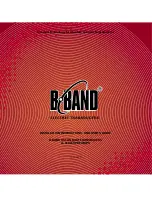
Print Date 12/05/15 Page 7 of 32 S7600-00MA-08
rear panel (E2023-03/04) with an additional TCP/IP monitor/control port on the rear (E2023-04 only).
When the RS232 port is provided on the rear panel, no parallel monitoring is available.
If a fault should occur within the E2023, manually operated switches on the E2024 Splitter/Drive
Changeover Unit can be used for basic control of the Transmitter. This enables it to be kept ‘on-air’
whilst the E2023 is replaced.
1.1.4 : E2024 Splitter /Drive Changeover Unit
This single unit interfaces between the Exciter(s) and the multiple E2021 Amplifier Module inputs. The
splitter section within the unit is either two way (S76005) four way (S7601) or eight way (S7602) and
consists of the appropriate number of cascaded two way Wilkinson 3dB power splitters. These all use
standard 75
Ω
coaxial cable, with 100
Ω
balance loads and are thus easily repaired if any become
damaged. All outputs are brought to SMC connectors at the rear of the unit. Phase length matched,
50
Ω
coax leads then connect these outputs to the E2021 inputs.
A front panel lockable toggle switch is provided to manually mute or start (i.e. demute) the Transmitter
or can be set to enable the E2023 Control Unit to select high/low power or to mute/demute the
Transmitter as part of an automatic control sequence. An interlock switch connector is also provided
on the rear to enable the open-circuiting of external switches placed at safety points (e.g. at Antenna
access gates) to automatically mute the Transmitter. The state of this circuit is displayed on a front
panel indicator.
As with the E2023, the rear of the E2024 has separate connectors for the two independent internal
Transmitter control buses
The E2024 can also provide manual or automatic dual drive changeover in conjunction with the E2023
Control Unit. A second front panel lockable toggle switch is provided on the E2024 to manually select
which Exciter (i.e. ‘Drive’) is to be used, or to enable the E2023 to automatically select the second
Exciter should the first one fail. Switching is performed by two coaxial RF relays within the E2024.
These direct one of two Exciter’s outputs to the internal splitter and the other to a dumping load. This
dumping load has to be provided (externally to the E2024) whenever two Exciters are supplied and the
Exciter not in use is required to remain ‘active’ or be tested. Three TNC connectors are provided at the
rear of the unit to connect to the Exciter(s) and the dumping load. Front panel indicators show which
Drive is selected.
1.1.5 : E2025 Combiner Unit
This single unit interfaces between the multiple E2021 Amplifier Module outputs and the antenna.
Phase length matched, 50
Ω
coax leads connect the E2021 outputs to the TNC connectors at the rear
of this unit. The combiner section within the unit is either two way (S76005) four way (S7601) or eight
way (S7602) and consists of the appropriate number of cascaded four or two way Wilkinson power
combiners utilising standard handformable and flexible coaxial cable.
The combiner section is followed by an integral low pass filter, this removing harmonics of the wanted
frequency. An output directional coupler is then provided with a 7-16 output socket for connection to
the antenna. This coupler is used to monitor the output forward and reverse power. A sample of the
forward power is also directed to a front panel BNC connector for easy connection to test equipment.
The E2025 also contains circuitry to measure the Transmitter’s final output forward and reverse
powers via the output coupler, the temperature of the Combiner’s integral dumping load heatsink and
the currents in the Transmitter’s dual cooling fans. Front panel red/green displays indicate any fault
condition. Two multi-turn preset potentiometers are accessible via the front panel to enable
independent setting of two Transmitter output powers. They are selected using various forms of local,
external or remote control or via a link on the Combiner/Fan connector Board (see section 3.4.2).
The single E2025 control connector goes to the two independent internal Transmitter control buses via
the Combiner/Fan connector Board, where it monitors the dual fans’ currents. As previously detailed,
each control bus has its own RS485 data bus, one of which is used to carry the monitored serial
information from the E2025 to the E2023 Control Unit. For these two buses, the E2025 also provides
two equal but independent power level control voltages (derived from either the front panel High or








































